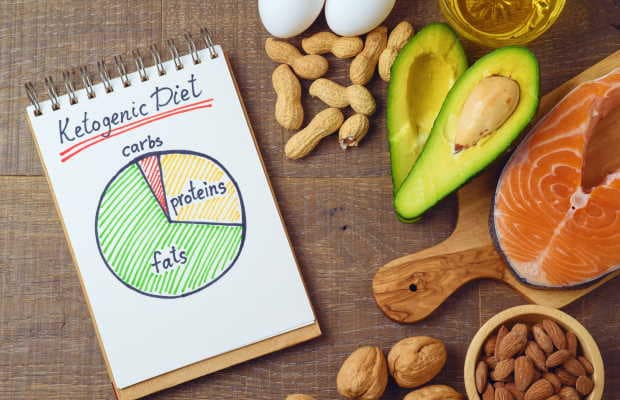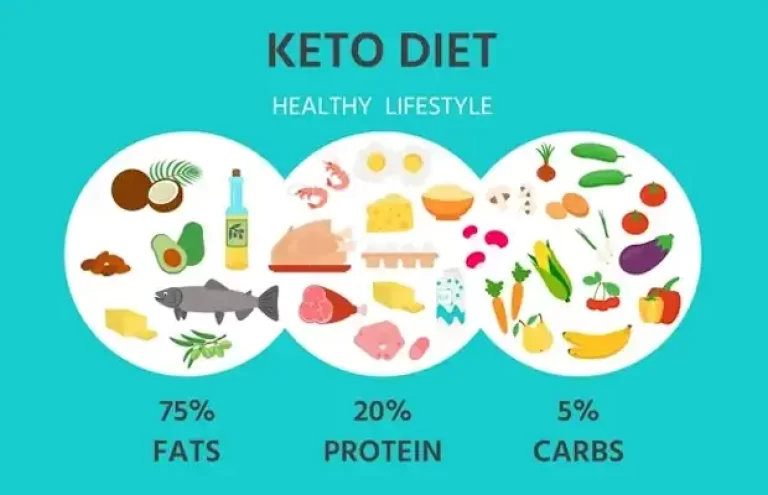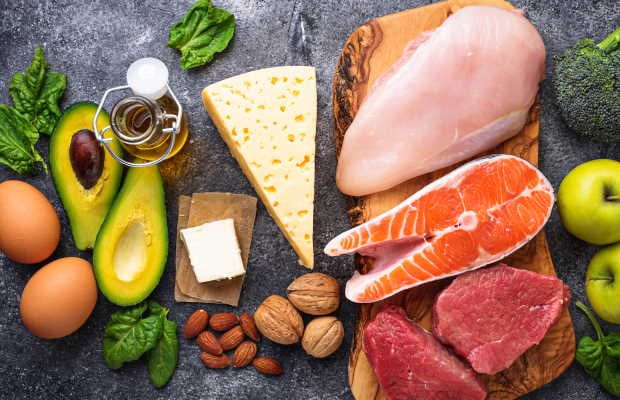
The search for a healthier lifestyle has led to the emergence of numerous diet trends, each of which promises remarkable results. Among these the keto diet has gained considerable attention for its potential to promote weight loss, improve metabolic health and enhance mental clarity.
In this comprehensive review, we delve into the fascinating world of the keto diet to understand its principles, benefits, and potential drawbacks.
What is keto diet
The keto diet is a high-fat, moderate-protein, and low-carbohydrate dietary approach. Its primary goal is to shift the body’s metabolism into a state called ketosis, where it primarily burns fat for energy instead of relying on carbohydrates.
Typically, the standard macronutrient ratio for a keto diet is approximately 70-75% of calories from fat, 20-25% from protein, and only 5-10% from carbohydrates. By severely restricting carbohydrate intake, usually to around 20-50 grams per day, the body depletes its glycogen stores and starts producing ketones from stored fat. These ketones then serve as an alternative fuel source for the body and the brain.
How keto diet works

The keto diet works by inducing a metabolic state called ketosis, where the body shifts from primarily using carbohydrates for fuel to utilizing stored fat as its primary energy source. This shift occurs due to the significant reduction in carbohydrate intake and the corresponding increase in fat consumption.
When you consume a diet high in carbohydrates, your body breaks down these carbs into glucose, which is used as the primary source of energy. Insulin, a hormone produced by the pancreas, helps transport glucose into cells for energy production.
In contrast, on a keto diet, carbohydrate intake is significantly restricted, usually to around 20-50 grams per day. With limited glucose availability, the body turns to an alternative energy source: stored fat. When the body doesn’t have enough glucose to meet its energy demands, it begins breaking down fatty acids from dietary fat and body fat stores into molecules called ketones through a process called ketogenesis. These ketones, particularly beta-hydroxybutyrate (BHB), are then utilized by various tissues, including the brain, as an efficient fuel source.
To achieve and maintain ketosis, the keto diet emphasizes high-fat intake, typically around 70-75% of daily caloric intake. This provides the necessary fuel for the production of ketones. Protein intake is moderated, usually around 20-25% of daily calories, to prevent excessive protein conversion into glucose through a process called gluconeogenesis, which could disrupt ketosis. Carbohydrates are significantly limited to minimize insulin release and keep blood sugar levels low.
By entering ketosis, several changes occur within the body:
1. Fat utilization
The body begins to rely on stored fat for energy, leading to increased fat burning and potential weight loss.
2. Appetite suppression
Ketones and a higher intake of fat and protein can help reduce appetite and promote satiety, making it easier to maintain a calorie deficit.
3. Improved insulin sensitivity
Lower carbohydrate intake and reduced insulin levels can improve insulin sensitivity and may benefit individuals with insulin resistance or type 2 diabetes.
It’s important to note that reaching a state of ketosis can take time, usually a few days to a week, as the body adjusts to using ketones as its primary fuel source. During this initial adaptation phase, some individuals may experience symptoms referred to as the “keto flu,” which may include fatigue, dizziness, nausea, and constipation. These symptoms are generally temporary and can be mitigated by proper hydration, electrolyte balance, and gradual adjustment to the diet.
It’s essential to consult with a healthcare professional or a registered dietitian before starting a keto diet, especially if you have underlying health conditions or take specific medications. They can provide personalized guidance and help monitor your progress to ensure safety and effectiveness.
Keto diet basic rules

The basic rules of the keto diet revolve around specific macronutrient ratios and food choices. Here are the fundamental principles to follow when adopting a keto diet:
1. High fat intake
The keto diet emphasizes consuming a significant amount of healthy fats. Aim for approximately 70-75% of your daily caloric intake to come from fats. Incorporate foods like avocados, nuts and seeds, olive oil, coconut oil, butter, and fatty fish into your meals.
2. Moderate protein intake
Protein is an essential component of the diet, but it should be consumed in moderate amounts. Aim for about 20-25% of your daily caloric intake to come from protein sources such as meat (beef, pork, poultry), fish, eggs, and high-fat dairy products (cheese, cream).
3. Low carbohydrate intake
One of the main rules of the keto diet is to restrict carbohydrate consumption significantly. Typically, this involves limiting daily carbohydrate intake to around 20-50 grams, although individual needs may vary. Focus on consuming low-carbohydrate vegetables, such as leafy greens, broccoli, cauliflower, zucchini, and peppers, while avoiding or minimizing high-carb foods like grains, legumes, starchy vegetables, and most fruits.
4. Monitoring ketosis
The ultimate goal of the keto diet is to achieve and maintain a state of ketosis, where the body primarily uses fat for energy. Monitoring your ketone levels can help ensure you’re on track. You can test ketones through urine, blood, or breath tests using specialized kits or devices.
5. Staying hydrated
Adequate hydration is crucial on the keto diet. Drink plenty of water throughout the day to support overall health and promote proper bodily function.
6. Pay attention to food quality
While macronutrient ratios are essential, it’s equally important to focus on the quality of the foods you consume. Choose nutrient-dense, whole foods, and opt for organic, grass-fed, and pasture-raised options whenever possible. Minimize processed and refined foods, as they often contain hidden sugars and unhealthy additives.
7. Adjusting gradually
Transitioning into a keto diet can be challenging for the body, especially during the initial adaptation phase. Consider gradually reducing carbohydrate intake over a week or two to help minimize potential side effects like the “keto flu.” This allows your body to adjust more comfortably to the changes in macronutrient ratios.
What are keto diet benefits

The keto diet has been associated with several potential benefits, although individual experiences may vary. Here are some of the commonly reported advantages of following a well-formulated ketogenic diet:
1. Weight loss
The keto diet is often praised for its effectiveness in promoting weight loss. By drastically reducing carbohydrate intake and increasing fat consumption, the body shifts into a state of ketosis, where it primarily burns stored fat for energy. This can lead to accelerated fat loss and improved body composition. Additionally, the keto diet may help control appetite and reduce cravings, which can further contribute to weight management.
2. Improved metabolic health
The keto diet has been shown to positively impact various markers of metabolic health. It can help lower blood sugar and insulin levels, potentially improving insulin sensitivity and glycemic control. This is particularly beneficial for individuals with type 2 diabetes or prediabetes. Some studies also suggest that the keto diet may lead to favorable changes in cholesterol levels by increasing HDL (good) cholesterol and reducing LDL (bad) cholesterol and triglycerides.
3. Increased mental focus and clarity
The brain can efficiently utilize ketones as an alternative fuel source. Some individuals report enhanced mental focus, concentration, and cognitive performance while following a keto diet. This is thought to be due to the steady supply of energy to the brain without the fluctuations associated with high-carbohydrate meals.
4. Potential therapeutic applications
The keto diet has shown promise as a therapeutic approach for certain medical conditions. For instance, it has been used for decades as an effective treatment for drug-resistant epilepsy, particularly in children. The diet’s neuroprotective effects are believed to contribute to seizure reduction. Additionally, emerging research suggests potential benefits for other neurological disorders, such as Alzheimer’s disease, Parkinson’s disease, and traumatic brain injury. The keto diet may also have positive effects on polycystic ovary syndrome (PCOS) and metabolic syndrome.
5. Increased satiety and appetite control
The high-fat and moderate-protein content of the keto diet can help increase feelings of fullness and reduce overall calorie intake. This can contribute to improved appetite control, making it easier to adhere to the diet and maintain a calorie deficit for weight loss.
6. Stable energy levels
By relying on fat as the primary fuel source, the keto diet may provide a more stable and sustained energy supply throughout the day. Many individuals report fewer energy crashes and improved endurance during physical activities.
It’s important to note that while the keto diet has potential benefits, it may not be suitable for everyone. Individual factors, such as existing health conditions, lifestyle, and personal preferences, should be considered when deciding to adopt this dietary approach.
What to eat in a keto diet

In a well-formulated keto diet, the focus is on consuming foods that are high in healthy fats, moderate in protein, and low in carbohydrates. Here are some examples of foods that can be included in a keto diet:
1. Healthy fats
- Avocados and avocado oil
- Coconut oil and coconut butter
- Olive oil
- Butter and ghee
- Nuts and seeds (almonds, walnuts, chia seeds, flaxseeds)
- Nut butters (peanut butter, almond butter)
2. Protein sources
- Meat (beef, pork, lamb, poultry)
- Fatty fish (salmon, mackerel, sardines)
- Eggs (including yolks)
- Full-fat dairy products (cheese, cream, yogurt)
- Plant-based protein sources (tofu, tempeh)
3. Non-starchy vegetables:
- Leafy greens (spinach, kale, lettuce)
- Cruciferous vegetables (broccoli, cauliflower, Brussels sprouts)
- Zucchini
- Bell peppers
- Cucumber
- Asparagus
- Mushrooms
4. Low-sugar fruits (in moderation)
- Berries (strawberries, blueberries, raspberries)
- Avocado
- Tomatoes
5. Dairy products (choose full-fat options):
- Cheese (cheddar, mozzarella, feta)
- Heavy cream
- Greek yogurt (unsweetened)
- Cottage cheese (in moderation)
6. Beverages:
- Water (plain or infused with lemon, cucumber, or herbs)
- Unsweetened tea (green tea, herbal tea)
- Coffee (black or with a small amount of cream)
What to avoid in a keto diet
Foods to limit or avoid on a keto diet include:
- Grains (wheat, rice, oats)
- Legumes (beans, lentils, chickpeas)
- Sugary foods and beverages
- Starchy vegetables (potatoes, sweet potatoes, corn)
- Most fruits (except for those mentioned above)
- Processed foods (snacks, sugary drinks, fast food)
- High-carb condiments and sauces (ketchup, BBQ sauce, honey, sugary dressings)
Remember, the specific amount of each food will vary based on individual calorie and macronutrient needs. It’s important to track your intake and ensure that you’re within the appropriate ranges of fat, protein, and carbohydrate for a keto diet.
Keto diet 7 days example plan
Here’s a sample 7-day meal plan for a keto diet:
Day 1
| Breakfast: | Scrambled eggs cooked in butter with spinach and feta cheese. |
| Lunch: | Grilled chicken breast with roasted broccoli and a side of avocado. |
| Snack: | Celery sticks with almond butter. |
| Dinner: | Baked salmon with steamed asparagus and a side salad dressed with olive oil and vinegar. |
| Dessert: | Sugar-free jello with whipped cream. |
Day 2
| Breakfast: | Ketogenic smoothie made with unsweetened almond milk, spinach, avocado, and a scoop of protein powder. |
| Lunch: | Cobb salad with mixed greens, grilled chicken, bacon, hard-boiled eggs, cherry tomatoes, and blue cheese dressing. |
| Snack: | Handful of macadamia nuts. |
| Dinner: | Zucchini noodles (zoodles) sautéed in olive oil with shrimp, garlic, and Parmesan cheese. |
| Dessert: | Keto-friendly chocolate mousse made with heavy cream and unsweetened cocoa powder. |
Day 3
| Breakfast: | Crustless quiche with bacon, cheese, and spinach. |
| Lunch: | Grilled steak with a side of cauliflower rice sautéed in coconut oil. |
| Snack: | Sliced cucumbers with guacamole. |
| Dinner: | Baked chicken thighs with roasted Brussels sprouts and a side salad. |
| Dessert: | Keto-friendly cheesecake with a nut crust. |
Day 4
| Breakfast: | Omelette filled with mushrooms, bell peppers, and cheese. |
| Lunch: | Tuna salad made with canned tuna, mayonnaise, diced celery, and served on a bed of lettuce. |
| Snack: | Hard-boiled eggs. |
| Dinner: | Baked pork chops with steamed broccoli and cauliflower mash (made with butter and cream). |
| Dessert: | Berries (such as raspberries or strawberries) topped with whipped cream. |
Day 5
| Breakfast: | Full-fat Greek yogurt topped with crushed almonds and a drizzle of coconut oil. |
| Lunch: | Cauliflower crust pizza with toppings of your choice (such as cheese, pepperoni, and mushrooms). |
| Snack: | String cheese. |
| Dinner: | Grilled salmon with sautéed spinach and a side of mashed avocado. |
| Dessert: | Keto-friendly peanut butter cookies. |
Day 6
| Breakfast: | Coconut flour pancakes topped with sugar-free syrup and a side of bacon. |
| Lunch: | Chicken Caesar salad with grilled chicken, romaine lettuce, Parmesan cheese, and Caesar dressing (without added sugars). |
| Snack: | Pork rinds with a side of guacamole. |
| Dinner: | Baked cod with lemon butter sauce, served with roasted asparagus. |
| Dessert: | Keto-friendly strawberry chia seed pudding. |
Day 7
| Breakfast: | Vegetable omelette made with bell peppers, onions, mushrooms, and cheese. |
| Lunch: | Beef stir-fry with broccoli, bell peppers, and a soy sauce substitute (like coconut aminos). |
| Snack: | Keto-friendly protein bar. |
| Dinner: | Baked turkey meatballs with zucchini noodles and marinara sauce. |
| Dessert: | Sugar-free dark chocolate squares. |
Remember to adjust portion sizes according to your individual calorie and macronutrient needs. It’s also essential to drink plenty of water and consult with a registered dietitian or healthcare professional for personalized advice and guidance when following a keto diet.
What are keto diet pills
Keto pills, also known as keto supplements or exogenous ketones, are dietary supplements designed to support the ketogenic diet. These pills typically contain ingredients such as beta-hydroxybutyrate , a ketone body that can be consumed orally.
The purpose of keto pills is to provide additional ketones to the body, which can help promote and maintain a state of ketosis. When you follow a keto diet, your body naturally produces ketones as it shifts to using fat for energy. Keto pills aim to boost ketone levels in the bloodstream, potentially enhancing energy levels, mental clarity, and athletic performance.
It’s important to note that keto pills should not be considered as a magic solution for weight loss or as a replacement for a well-formulated ketogenic diet. While they may provide some benefits, they are most effective when used in conjunction with a proper diet and lifestyle.
If you’re considering using keto pills, it’s recommended to consult with a healthcare professional or registered dietitian. They can provide personalized guidance, assess your specific needs, and help determine if these supplements are suitable for you. Additionally, it’s crucial to choose high-quality keto pills from reputable sources to ensure safety and effectiveness.